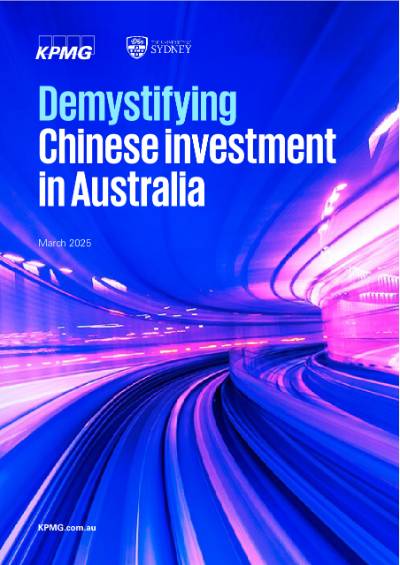As part of the ongoing series of Demystifying Chinese Investment in Australia by KPMG and The University of Sydney, the April 2024 report analyses Chinese Overseas Direct Investment (ODI) into Australia in calendar year 2024.
In 2024, Chinese investment in Australia increased by 41%, from US$613 million in 2023 to US$862 million. In Australian dollar terms, the increase is 43%, from AU$917 million in 2023 to AU$1,312 million. Eleven completed transactions were recorded in 2024.
Highlights of Chinese investment into Australia in 2024
Key findings
2024
Chinese investment in Australia increased by 41%, from US$613 million in 2023 to US$862 million.
In Australian dollar terms, the increase is
43%
from AU$917 million in 2023 to AU$1,312 million.
Despite the increase, 2024 had the
third-lowest
investment value and number of transactions since 2006, only higher than 2021 and 2023.
By industry
Mining saw a significant increase from AU$34 million in 2023 to AU$1,124 million in 2024 and accounted for
86%
of the total investment value with 9 deals.
One renewable energy investment contributed
14%
or AU$183 million of the overall value.
One investment in the technology sector in the area of payment solutions accounted for
< 1%
or AU$5 million, of the overall value.
The global context
According to recent data from UN Trade and Development (UNCTAD), global Foreign Direct Investment (FDI) in 2024 declined by 8%, excluding financial flows through European conduit economies.
Regional FDI tells a diverging story. After adjusting for the conduit economies effect, UNCTAD notes a steep 45% decline in FDI flows into continental European economies (Germany, Poland, Italy, Spain, and France), contrasting with a 13% increase in North America. The United States was the leading recipient of global FDI, registering a 10% increase in FDI mostly driven by large M&A deals. Large M&A acquisitions were also completed in Italy, Ireland, and Germany.
Developing economies presented a mixed picture, with overall FDI falling by 2% . Several major emerging economies—including Brazil, China, India, Indonesia, and Mexico— experienced declines in project numbers that far exceeded the global average. For example, FDI flows into China declined 29% in 2024.
Besides China’s Ministry of Commerce data, project-based data from the Rhodium Group shows that Sub-Saharan Africa countries experienced their highest growth in Chinese ODI in 2024, while Chinese ODI into North America continued to decline.
Contact KPMG's Asia Business specialists
Demystifying Chinese Investment in Australia – all editions
Previous editions
- April 2024 (PDF 1.4MB)
- April 2023 (PDF 1.8MB)
- April 2022 (PDF 813KB)
- July 2021 (PDF 5.3MB)
- June 2020 (PDF 1.2MB)
- April 2019 (PDF 2.6MB)
- January 2018 (PDF 2.3MB)
- June 2018 (PDF 2.6 MB)
- May 2017 (PDF 2.9MB)
- April 2016 (PDF 1.8MB)
- May 2015 (PDF 2.3MB)
- March 2014 (PDF 1.12KB)
- August 2014 (PDF 2.7KB)
- November 2014 (PDF 1.1KB)
- March 2013 (PDF 2.3MB)
- October 2013 – Agribusiness (PDF 1.5MB)
- August 2012 (PDF 1.7MB)
- Australia & China: Future partnerships 2011 (PDF 3.1MB)
- November 2011 (PDF 871KB)






